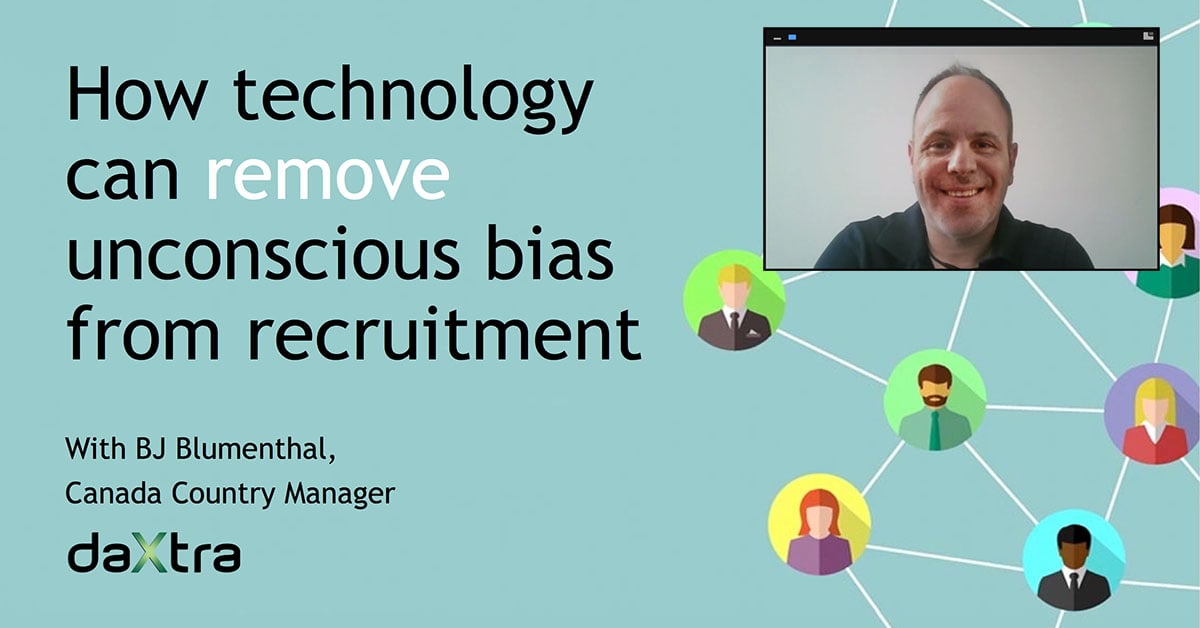Our Canada Country Manager, BJ Blumenthal, recently presented a webinar hosted by TorontoJobs.CA on "How technology can remove unconscious bias from recruitment."
The webinar focused on the different aspects of unconscious bias and how it can affect the hiring process and covered the technology that can help remove some of the factors that contribute to biased decisions in candidate sourcing and hiring.
Just what are the new innovative tools your business needs to focus on skills, education and achievement, to hire the best, most suitable candidates to fill your positions?
The swelling popularity of today's civil rights movements have spurred companies to rethink their tactics of promoting diverse populations within their workforce. This, coupled with studies that link a diverse workforce with greater production and more profitable bottom lines, has made the initiative for hiring a diversified population a no-brainer.
What is unconscious bias?
In the hiring process, unconscious bias happens when you form an opinion about a candidate based solely on first impressions - when you prefer one candidate over another simply because you may identify with them in some way.
The challenge is that unconscious bias can affect every stage of the hiring process and is hard to monitor, precisely because it happens unconsciously.
When candidates are screened, their name, postal code or where they went to college may sway a decision about them. These insignificant details can influence a biased decision.
Types of unconscious bias:
- perception bias: basing your opinion about a person on a set of stereotypes and assumptions
- confirmation bias: looking to confirm your pre-existing ideas about a person
- affinity bias: preferring a person with similar qualities to you
- halo effect: thinking everything is good about a person because you like them
- conformity bias or groupthink: trying to fit your opinion to the views of the group
Perception bias
Does someone's name make you form an opinion of them? It most certainly can. It could be that your mother-in-law has the same name. It could be that this name sounds as if the person may hail from another country. This name may be one you think belongs to a certain age group. Each of these examples are instances of unconscious bias. They fall under the category "perception bias," in that they are based on an opinion formed from a set of stereotypical assumptions.
Confirmation bias
A confirmation bias is a type of cognitive bias that involves favoring information that confirms your previously existing beliefs. We make snap decisions based on perceived truths and then spend the rest of the time, subconsciously or not, trying to justify our bias. This is when we ask irrelevant questions, trying to elicit answers that support our initial assumption about the candidate.
Affinity bias
When we feel a natural rapport towards a candidate due to something we have in common with them — we come from the same town, went to the same school, know the same people — we are exhibiting signs of "affinity bias."
As recruiters, we may allow this feeling of affinity to affect our behavior in the interview and influence our decision when it comes to hiring. We believe there is a connection there and place emphasis on something that isn’t tangible nor relevant to the hiring decision.
Halo effect
This hiring bias is when the recruiter waives proper investigation of a candidate’s background, choosing instead to focus too heavily on a positive aspect of a candidate, like where they went to school, or what sports they participate in, and rely on that one thing when making decisions.
We zero in and let that golden halo guide us and our opinion of the candidate. Abandoning all other information about them, we are blindsided by this one thing about them, the thing we believe makes them so great.
There's also the "horn effect" which is the opposite — when the recruiter focuses too negatively on one gloomy aspect of the candidate’s CV.
Conformity bias
Conformity bias, otherwise known as peer pressure, results from our fear of being thought poorly of by our peers and allows us to be swayed by others.
Going along with the crowd's opinion of a candidate to match the opinion of the majority is very common. The majority isn't always right, so forming your own opinion independently is a much better practice.
Effect on recruitment
Unconscious bias plays a larger role than we would imagine in the hiring process as established by the unrealized assorted biases we have.
It can have a strong impact on a business in a trickle down effect:
- Limits candidate selection with a potential to exclude strong, more qualified candidates
- Enables hiring for the wrong reasons – likes or dislikes over qualifications
- Creates increased turnover potential.
Eliminating unconscious bias using technology
Impeding the opportunities an organization has for growth and potential, unconscious bias in the hiring process is detrimental. It should be identified and training measures should be put in place. Other measures involve implementing technology solutions.
DaXtra has several solutions to reduce unconscious bias in the sourcing, matching, ranking and reviewing portion of the hiring process.
- Automated data loading – Apply and Match, DaXtra Capture and DaXtra Styler
- Candidate search – DaXtra Search Nexus
- Building blocks - DaXtra Components: DaXtra Parser, Search & Match Web Services and TalentPool
Automated data loading and anonymization
Creating a better candidate experience by offering a fast and user-friendly way to apply online, fully integrated with your careers portal, Apply & Match enables candidates to effortlessly apply for roles quickly. It automatically matches the candidate to existing jobs in your database and recommends them based on the candidates work and education experience alone.
To automatically deduplicate and load candidate data from all monitored sources of incoming resumes to your existing database, DaXtra Capture is used as a parsing and loading tool. It builds value and uniform structure in your data. This allows for accurate reporting for government issued equal opportunity requirements.
DaXtra Styler then comes into play for presenting resumes to hiring managers or clients. It anonymizes resumes taking out name, dates, school names, affiliations so the resume focuses on skill and ability.
Candidate search
In sourcing candidate we search and match candidates to jobs. DaXtra Search Nexus focuses on skill and job title. When searching by job title, it uses a feature that suggests other related synonyms or aliases of that title, broadening your scope.
Using natural language processing it is able to semantically understand the context of the keywords used depending on the surrounding words, much like a human does. It can therefore distinguish job titles from skill or location. For instance, if you are searching for a Medical Doctor, or MD, it can differentiate MD (Medical Doctor) from MD (Maryland) or MD (Managing Director.) It could also tell if you worked at Adobe versus having experience on Adobe products.
One of the great features of DaXtra Search Nexus is that it searches over your own database, job boards and online sources simultaneously, all without leaving your CRM. It then ranks candidates and shortlists them to jobs or candidate lists in your database.
Building blocks
DaXtra Components are easy-to-implement developer building blocks and web services that streamline and automate recruitment processes.
- DaXtra Parser – able to control what information is populated in the candidate records
- Search & Match Web Services – search over documents and structured data fields, match candidates and jobs using context and experience, add or update records and index your entire candidate database
- TalentPool - builds a pipeline of quality passive candidates, creating candidate records directly in your CRM, even without a resume.
Results
Through the anonymization of fields, removing name, dates, school names, affiliations and so forth, and searching and ranking conducted on skill and ability, we are able to source and present qualified candidates whose skills and aptitude fit the requirements of the jobs, rather than let other insignificant details influence our decisions.
The results are:
- Employees with the best skill sets
- Reduction in staff turnover
- Diverse and inclusive workforce
- Compliance with government imposed and/or company diversity policies
- Increased productivity
- Increased company profits
The obvious danger with unconscious bias is that we could be passing over great candidates for no real reason at all. If the ultimate goal is the best fit for the job, then intelligent automation solutions are viable tools to help achieve this.
We encourage you to reach out to us with any questions you may have on the solutions DaXtra offers to help fight bias in hiring and stay tuned for an ebook on the subject we'll be publishing soon!



